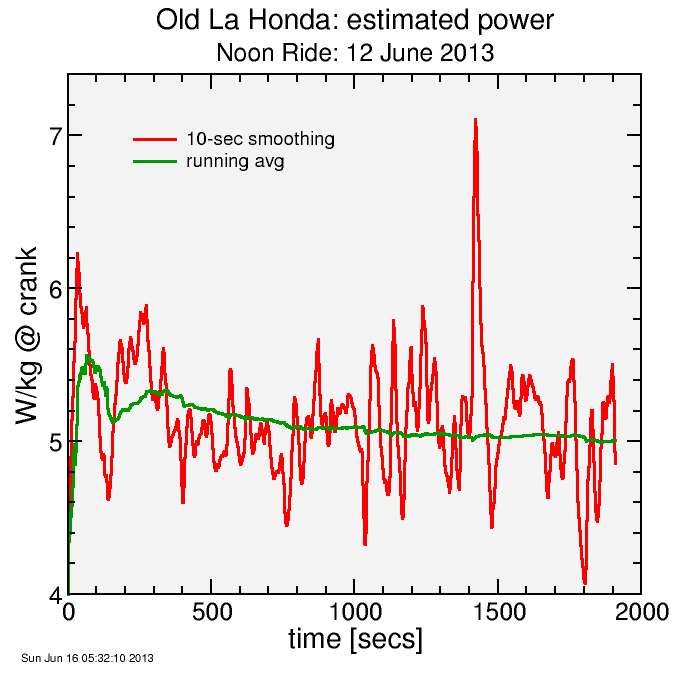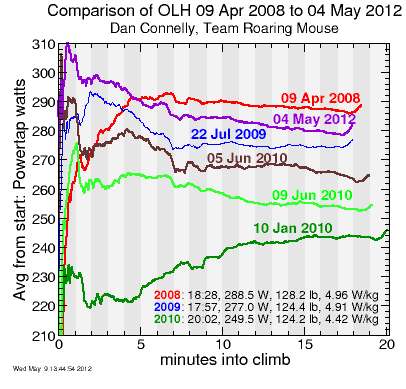Old La Honda: chasing Chris
This past Wednesday was my first Wednesday Noon Ride up Old La Honda. The previous week was going to be my first, but I had some mechanical issues which prevented me from doing the climb after arriving to the base with the group. This time, however, I had everything under control and I reached Old La Honda with the surprisingly small noon-ride group.
On the approach I chatted with Chris Evans who declared he was going to begin the climb hard. He'd done a sub-17 the week before, he said, and since he was more tired today, was shooting for 17:30. That was the goal I had set for myself on Strava, so it seemed like he was a good pacing match for me. But It was just my first time doing Old La Honda this year, and I'd been riding a relatively lot due to trying to prepare for the upcoming Alta Alpina 8-Pass Challenge so was a bit tired. These factors meant a really fast start didn't seem wise. Instead I decided to let Chris have his fun early and just try to pace myself.
I was without power data for the ride, since I was using my Reynolds carbon tubular wheels rather than my Powertap clincher wheel: I'd had the tubulars on the Fuji for the Berkeley Hills Road Race, and had kept them on for the Pescadero Road Race, which I'd ended up skipping due to allergies/sickness the week before. It's not that big a deal to switch wheels, but it also requires changing brake pads, which is a slight hassle. In any case, I wanted to test my road race configuration on the 84 descent which follows the Old La Honda climb. I've never descended well on the carbon rims, with my Zero G brakes and Swissstop yellow brake pads. Sure, and there was the fact the carbon wheels were light and likely fast. It's always nice to shave a few seconds off an Old La Honda time if possible. The downside is I wasn't carrying a spare so if I flatted I was going to have an interesting time getting back to work. I didn't flat, however.
Chris shot off the front of the group heading to the base of the climb, and I followed, although he opened a small gap. The gap exploded when we hit the bridge marking the start of the timed climb. True to his word, he was starting quickly. I just tried to tap into what I thought was a good pace: a decent effort but sustainable. If I'd had the PowerTap I'd have tried to keep it in the 300-watt range here, but instead I had to rely on perceived exertion. Chris' gap stabilized before he was out of sight, though, and I spent the rest of the climb monitoring my progress relative to the distance between us.
Along the way I noted the trees bending in the wind. There's usually not much wind on Old La Honda Road, as it's protected from the ocean breezes by the mountain ridge. The wind was a headwind during at least one corner. I'm not sure if it netted out to head or tail.
As we reached the end game, a large truck descended the road. I could see Chris squeeze by: he later told me he'd ridden on the dirt off the side of the road. As the truck approached me, I could see it was making no accommodation for my presence. After all, if I failed to get out of his way, he'd be the only witness, so what risk was it to him? So picking survival over OLH time, I pulled off the road, and stopped.
The truck passed without slowing, and when it had I clipped back in and set off. The recovery + adrenaline gave me a short-term boost which made up some of the 7 seconds lost on the road edge before reality kicked back in and I resumed a regular climbing pace. This incident probably cost me a net 3-4 seconds, factoring in the recovery gained with the delay.
Chris had gained time on me here, though, and was further up the road. It was just a few more corners to the finish. I hit my lap time at the stop sign in 17:12. I think that's my 4th or 5th best time ever (after 16:38, 16:49, 17:03, at least) Chris had beaten 17 for the second week in a row, so it was a nice result for him, confirming his climbing was good right now.
Since I didn't have a power meter, I had to analyze pace by looking at my altitude, distance, and time. I assumed CdA = 0.4 m2, air density = 1.2 kg/m3, rolling resistance coefficient = 0.4%, body mass = 57 kg, bike mass = 6 kg, extra mass = 2 kg, and drivetrain efficiency = 97% (note this corresponds to SRM or Quarq or Vector power, not Powertap power). Here's the result:

I started a bit fast, despite my goal to start conservatively. But on Old La Honda this probably isn't a bad thing: it's a short climb, so the penalty for a fast start is less than it would be for a climb twice as long, for example. I faded during the climb, but I never cracked. I lost a bit when I stopped for the truck. I was able to get back above average power after this, but this surge probably cost me my finishing kick. So the truck definitely cost me time.
I had to be happy with this effort. Under better circumstances: less wind, no stopping, and going into the climb fresher, I clearly would have been able to break 17. Whether my 16:36 from two years ago is still accessible is another question.
As an aside, here's some data from previous efforts. My power from this one stacks up nicely, although these were measured with a PowerTap, which doesn't include drive-train losses. Neglecting the 3% drivetrain loss my estimated power on this one was 277 watts @ 57 kg = 4.86 W/kg, so this was a competitive but not exceptional effort if you don't consider the wind and the stop for the truck. Note I have a tendency to go out a bit hard. But as long as I don't fade badly, that's probably not a mistake, as I noted: Old La Honda is a relatively short effort.

Also note in every one of these previous efforts I managed a decent upturn in power at the end. This time I didn't. The reason is likely that I spent my surge capacity in the adrenaline-rushed acceleration after being stopped, so I had nothing left for a strong finish. Just looking at the seconds including and following the stop, I might convince myself I was able to make up most of the lost 7 seconds, but I paid a price for that later.
Of course, comparing PowerTap data to estimated power data is not very precise. There's errors on both sides of the comparison. The wind alone, even if relatively light on the hillside versus exposed ridges, is a large source of potential error. This sort of analysis is no substitute for a well-functioning power meter.

Comments
The hard opening jump also opens up my legs and lungs and I feel better at threshold after doing a minute or 3 above.
And then there's the feeling of being chased. It's good motivation.
ymmv, but I've done the same at Diablo TT the last two years and won my heat each time, so it works for me.
The hard opening jump also opens up my legs and lungs and I feel better at threshold after doing a minute or 3 above.
And then there's the feeling of being chased. It's good motivation.
ymmv, but I've done the same at Diablo TT the last two years and won my heat each time, so it works for me.